| If you can't see this e-mail properly, you can also view it online |
 |
|
NetLetter #1335 | January 31, 2016 |
|
|
 |
|
|
 |
|
|
|
 |
|
|
Tracey Curtis-Taylor in her 1942 Boeing Stearman
|
|
|
|
|
|
|
|
|
|
Dear Reader,
Welcome to the NetLetter, an Aviation based newsletter for Air Canada, TCA, CPAir, Canadian Airlines and all other Canadian based airlines that once graced the Canadian skies.
The NetLetter was created in 1995 by Vesta Stevenson (RIP) and Terry Baker and is normally published every two weeks (we're late sometimes). If you are interested in Canadian Aviation History, and vintage aviation photos, especially as it relates to Trans-Canada Air Lines and Air Canada then we're sure you'll enjoy this newsletter.
|
|
|
|
|
|
|

ACFN/NetLetter News
|
|
|
|
|
In the last NetLetter we announced that we would be sending future NetLetters out on time. So here we are a day late already, (but much closer to our target). This may not matter to most of you, but it does to us and we want to keep on track and provide you with a timely newsletter on a consistent basis. Because we usually send the NetLetter out on weekends, we will need to modify our previously announced schedule in order to adopt to this. So instead of the 15th and 30th of each month, as previously planned, we will change this to the second and fourth weekend of each month.
So except for this NetLetter, you can expect future NetLetters on the weekends of February 13, 27; March 12, 26; April 9, 23; May 14, 21 and so on. This works well with most months and for the months with 5 Saturdays we may throw in a special issue there with varying content.
Thanks for your patience while we get our "ducks in a row".
Pionair's Membership Drive
 Our friends at the Pionairs have announced a new Membership Drive in the form of a Membership Recruitment Contest with impressive prizes of two iPads (Air 2) being given away with a value of nearly $450 each. Our friends at the Pionairs have announced a new Membership Drive in the form of a Membership Recruitment Contest with impressive prizes of two iPads (Air 2) being given away with a value of nearly $450 each.
If you are presently a Pionair member in good standing you can refer a friend and will then be automatically entered into the contest. The new member who joins is also eligable to win. To take advantage of this contest, if you are not a Pionair, find someone you know who is a Pionair and  add their name, email and employee# in the application's referral area when you are applying for membership. If you are already a Pionair, if you wish, you can add your friends info on their behalf and add yourself as the referrer. If you don't know anyone that is a Pionair, just add "The NetLetter" in the space for the referral name so they know you were referred by us. There is also a downloadable PDF file that you can mail in by Canada Post if you have problems filling out forms online. add their name, email and employee# in the application's referral area when you are applying for membership. If you are already a Pionair, if you wish, you can add your friends info on their behalf and add yourself as the referrer. If you don't know anyone that is a Pionair, just add "The NetLetter" in the space for the referral name so they know you were referred by us. There is also a downloadable PDF file that you can mail in by Canada Post if you have problems filling out forms online.
Eligible entries will be accepted up until JUNE 30th, 2016 for the first draw, and up until DECEMBER 31st, 2016 for the second draw. In addition, one pair of AC POS passes (PY2/J00) will also be drawn in January 2017.
Full details of the contest can be viewed at: www.pionairs.ca/images/pdf/membership_campaign.pdf and you can apply for Pionairs membership directly at: www.pionairs.ca/new-registration-info
BENEFITS FOR PIONAIRS MEMBERS
 Access to valuable information on pensions, health care, travel and other benefits. Access to valuable information on pensions, health care, travel and other benefits.
 Advocacy efforts and representation by your Association towards pension security and issues that matter to you. Advocacy efforts and representation by your Association towards pension security and issues that matter to you.
 Monthly newsletters of events, editorial and news at National and District levels. Monthly newsletters of events, editorial and news at National and District levels.
 Pionairs Travel Assistance volunteers (where available by District). Pionairs Travel Assistance volunteers (where available by District).
 Invitation to the Annual General Meeting/AGM, under the umbrella of the Annual Pionairs Conference/APC, open to all members. Invitation to the Annual General Meeting/AGM, under the umbrella of the Annual Pionairs Conference/APC, open to all members.
 Regular social gatherings and theme events for members and guests. Regular social gatherings and theme events for members and guests.
 A wealth of information for current and future members on our website at www.pionairs.ca A wealth of information for current and future members on our website at www.pionairs.ca
|
|
|
 |
|
|

Women in Aviation
|
|
|
|
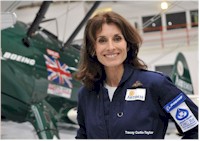 A British woman completed a 20-day solo flight from England to Australia in a Stearman on New Year's Day, commemorating a flight made by Amy Johnson in 1930. Tracey Curtis-Taylor, 53, landed at Darwin to complete the 8,000-mile trip, which began October 1, 2015. A British woman completed a 20-day solo flight from England to Australia in a Stearman on New Year's Day, commemorating a flight made by Amy Johnson in 1930. Tracey Curtis-Taylor, 53, landed at Darwin to complete the 8,000-mile trip, which began October 1, 2015.
"I'm feeling just a bit windblown, sunburnt and a bit punch drunk," Curtis-Taylor told media after she touched down. "This is where Amy Johnson touched down in 1930, so Darwin was the big moment for her. Amy was a 20th-century icon in terms for what she achieved. My flight is very much a tribute to her. It is celebrating what the pioneers achieved and what women now achieve in aviation."
Curtis-Taylor flew through 23 countries on her way to Australia, loosely retracing the route of Johnson. Although she used GPS on the trip, the Stearman was equipped pretty much as it was when it rolled off Boeing's assembly line in 1942. Johnson flew a Gipsy Moth on her flight. She flew numerous other record-breaking flights during the 1930's until the Second World War started. Johnson became a ferry pilot and was killed in 1941 after her plane went down in the Thames on a ferry flight. There were some reports that she was shot down by the British after she failed to give the correct radio contact codes.
You can visit Tracey's web site at: www.birdinabiplane.com for more information. Click on map below for full size map of her trip.

|
|
 |
|

Air Canada News
|
|
|
|
Air Canada has announced an increase to its service from YVR to Brisbane, Australia.
 The new, daily non-stop service begins June 17, 2016 and is thanks to a revised bilateral agreement between Canada and Australia that enables increased service between the two countries. Flight AC35 will depart YVR daily at 11:45 p.m. and arrive in Brisbane at 7:15 a.m. (+2 days). Flight AC36 will depart BNE daily at 10:40 a.m. and arrive at YVR at 7:15 a.m. Air Canada will operate a state-of-the-art Boeing 787-8 Dreamliner aircraft. (source YVR newsletter). The new, daily non-stop service begins June 17, 2016 and is thanks to a revised bilateral agreement between Canada and Australia that enables increased service between the two countries. Flight AC35 will depart YVR daily at 11:45 p.m. and arrive in Brisbane at 7:15 a.m. (+2 days). Flight AC36 will depart BNE daily at 10:40 a.m. and arrive at YVR at 7:15 a.m. Air Canada will operate a state-of-the-art Boeing 787-8 Dreamliner aircraft. (source YVR newsletter).
On January 7th, 2016, flight AC1999 from Amman, Jordan arrived at Toronto’s Pearson International Airport. This is the first of five flights to be operated on behalf of the Canadian Government that will bring almost 1,500 Syrian refugees to Canada. The crew consisted of President and COO Klaus Goersch as Captain of the Boeing 787-9 Dreamliner. Captain Michael Deere; Relief Pilot Jonathan Tremblay; Service Directors Hilaire St Pierre and Candace Crossan; Manager, Inflight Operations Paola Campacci; Flight Attendants Andrea Atiyeh, Helene Carmichael, Imad Zaoude, Lancia Samuels, Rana Subeih, Randa Elmaassarany, Roxanne Holmes and Soufiane Kouame. (source Daily Jan 7/16) |
|
 |
|
|

Reader Submitted Photos
|
|
|
|
|
Jean-Rene Cadorel has sent us this message and photos.
The recent passing of Captain Gordon Jones, super instructor and gentleman, AC retired, prompted me to dig into my dusty files. In 1976, Air Canada leased two DC8s to Cubana de Aviacion and trained the crews. On Thursday March 18th 1976, Gordie Jones was finalising the route checks of 2 Cuban pilots, on the flight from Montreal to Havana.
The incoming DC8 had been cleared for the approach but wasn't told about an Antonov from Cubana, in pilot training, holding at the NDB near Havana-José Martí International Airport (HAV).
The two aircraft met almost head-on, at night, no lights on the twin turboprop. This resulted in the Antonov losing both wings (and unfortunately 5 Cubana pilots), the DC8 losing engine #1, seriously damaging eng #2. damaging the flaps and missing some 10 feet of the left wing tip.
Gordie jumped into the left seat, removing the Cuban pilot, took control, shut down eng #2, assessed the flying abilities of the aircraft and completed the 2-engine landing. The attached photos tell the story. The AC Captain looking at the damage is Vern Ehman, instructor.
I apologize for the quality of the photos. Also included is a picture of Captain Vern Ehman AC with Ernesto Machin, of Cubana.
Keep the blue side up, Captain Jean-Rene Cadorel, AC retired.
(The aircraft was CU-T1200 ex Air Canada fin 811 c/n 45638 CF-TJK. – eds)
|
 |
|
 |
 |
|
 |
|
|
|
 Brian Losito has sent us some photos from the TCA/Air Canada archives. Here we have the crew of a North Star circa 1953. Brian Losito has sent us some photos from the TCA/Air Canada archives. Here we have the crew of a North Star circa 1953.
|
|
|
 |
|
TCA/AC People Gallery
 |
|
|
|
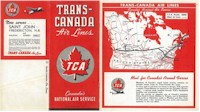
1944 - July - Timetable Trans-Canada Air Lines from the private collection of Bjorn Larsson.
|
|
Found in the “1944 Annual Report”
|

- Aircraft fleet as of December 31st, 1944 were 14 Lockheed 14-08 and 12 Lockheed Lodestars.
- On July 1st, 1944 one round trip was rerouted in the Maritimes to pass through Blissville NB.
- Daily flights were begun between Halifax and Sydney, Nova Scotia.
- On December 30th, 1944 the Lancaster operating the Canadian Government Trans-Atlantic Air Service (CGTAS) CF-CMU fin 102 under the command of Captain Maurice Gauthier was tragically lost during the crossing from Montreal to Prestwick.
|
|
We located this in the "Horizons" magazine issue dated December 1979.
|
|
 Shown during the ribbon cutting ceremony marking the opening of the Hamilton's new city sales office during the fall of 1979 are... Shown during the ribbon cutting ceremony marking the opening of the Hamilton's new city sales office during the fall of 1979 are...
From the left: Elenore Duncan, Ken Bruce, W.W.Shater, John McMurtry, VP Cenral Region cutting the ribbon; Jim Shimmin, Kay Kelly and Harry Fase, Manager, Central Region. The expanded facility was hoped to meet the demands of the Hamilton market, the second largest in Ontario at the time.
|
|
Found in the "Parts and Pieces" stores magazine" issue dated March 1988
|
|
 During February a visit was made to the London (LHR) stores, and here we have this photo of some of the employees - Dave McKellow, Keith Gregson, David Coles, John Cleary, Michael Coon, Pamela During February a visit was made to the London (LHR) stores, and here we have this photo of some of the employees - Dave McKellow, Keith Gregson, David Coles, John Cleary, Michael Coon, Pamela
Hall, Ralph King, Bert Hutton and Alexis McWhirter.
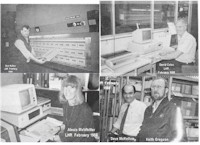
Missing during the photo ops were Terry Denny, Barry Knox, Peter Hodge and Gordon Duddy.
|
|
|
 |
|

Alan's Space
|
|
|
|
 This is what it was like to fly in the 1930s This is what it was like to fly in the 1930s
(Submitted by: David Bellamy )
While mankind’s foray into flying began in the early 20th century, the modern air travel industry as we know it didn’t truly grow its roots until the 1930s. As metal planes returned home from post-war posturing, a boom in passenger interest and sufficient technology to reach a slew of international destinations made the 1930s the start of something big. But like any major technology, commercial flight didn’t come without growing pains. If you think you have a lot to complain about now when it comes to air travel, take a look at what it was like to fly in the 30s.


|
|
 |
|
CPAir, Canadi>n People Gallery
|
|
|
|
|
Help wanted-
Marc Herpers is searching for the whereabouts of George McBurnie, a former CP Air & Canadian Airlines Employee. "George and I where good friends in the 80ies and 90ies. He visited our family in the Netherlands, as i visited him twice as he was then living in Ladner BC. Sadly we lost contact over the years. By searching the web I crossed your page and saw his name! I would be more than happy if you can help me out with any kind of information!"
Thank you in advance. This email address is being protected from spambots. You need JavaScript enabled to view it.
(Should anyone have a contact for George, you may send it direct to Marc – eds)
|
|
|
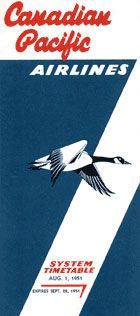 1951 - August - Timetable Canadian Pacific Airlines from the private collection of Bjorn Larsson. 1951 - August - Timetable Canadian Pacific Airlines from the private collection of Bjorn Larsson.
1967 - January 30th - CP Air inaugural service between Vancouver and San Francisco.
1995 - October 29th - Service Vancouver - Reno - Las Vegas commenced.
1995 - November 3rd - Service Vancouver - Kuala Lumpur in partnership with Malaysia Airlines.
|
|
Found in the “Canadian Pacific Airlines Newsletter” magazine issue dated October 1963.
|
|
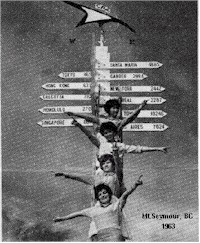 Competing with the CPA emblem on aerial "mile zero" post overlooking Vancouver on Mt. Seymour are four headquarter girls representing CPA destinations. Competing with the CPA emblem on aerial "mile zero" post overlooking Vancouver on Mt. Seymour are four headquarter girls representing CPA destinations.
From the top: Lorraine Tanaka (Japan), Deanne Wong (Hong Kong), Margaret Heywood, an Australian, and Marietta Ramaer, Dutch.
The sign was erected by the North Shore Tourist Bureau with CPA participation.
(Does anyone know if this weathercock still exists? - eds)
|
|
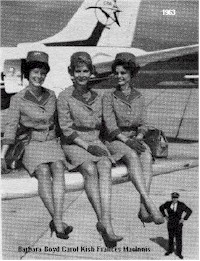 Widespread publicity for CPA resulted from this photo of three stewardesses on a DC-8 wingtip. All are former beauty queens. From the left: Barbara Boyd, finalist for Miss Calgary Stampede; Carol Kish, Miss Pacific National Exhibition, and Frances MacInnis, Miss Winnipeg. Widespread publicity for CPA resulted from this photo of three stewardesses on a DC-8 wingtip. All are former beauty queens. From the left: Barbara Boyd, finalist for Miss Calgary Stampede; Carol Kish, Miss Pacific National Exhibition, and Frances MacInnis, Miss Winnipeg.
Oh, and that's Bob Schumacher far below.
|
|
Issue dated July 1963
|
|
 A new trans-pacific record from Vancouver to Tokyo of eight hours 28 minutes was established on July 3rd, 1963 by Captain Craig Stevenson and his crew in DC-8 fin 603. It eclipsed the previous record set by Captain Cec McNeal in January. The record breaking crew departing for Vancouver are... A new trans-pacific record from Vancouver to Tokyo of eight hours 28 minutes was established on July 3rd, 1963 by Captain Craig Stevenson and his crew in DC-8 fin 603. It eclipsed the previous record set by Captain Cec McNeal in January. The record breaking crew departing for Vancouver are...
from the left: Judy Inamasu, Carol Shimozawa, W.Tu replacing Frank Ling at Hong Kong, Navigator Joe Nowazek, First Officer Rick Kilburn, Captain Craig Stevenson, Second Officer Gordon Richardson, Purser Arnie Roeske, Joanne Louie (trainee stewardess) and Edith Underhill.
|
|
|
 |
|
 Wayne's Wings Wayne's Wings
|
|
|
|
 A New Career Begins A New Career Begins
I decided to retire while recovering from (successful) back surgery in the Spring of 2015. I had reached the thirty-five-year milestone and still enjoyed my job and the company of my colleagues but I was tired of checking my work schedule to plan my life. I want to indulge myself in the pastimes that I enjoy such as working on web sites and travelling to Cribbage tournaments as well as seeing more of our planet.
So I chose to work out the rest of the year and begin 2016 as a retiree. I attended an I.A.M. Retirement Seminar in early December and left with my decision reinforced. The company and our pension plan are in excellent shape; the time is right. However, I still wondered how I was going to react my last day as an active employee.
As it happened, my last full working days were Christmas and Boxing Day of 2015, followed by four days off with the last official day being New Year’s Eve. The usual ceremony of cake and coffee had been prepared and I was asked to be there for 13:00. I arrived at the Ops Centre early (as usual) and did something that I had been doing subconsciously for years; I slipped a lanyard with my R.A.I.C. pass and key card over my head.
Inside I was greeted by warm smiles, handshakes, hugs, congratulations and thoughtful gifts (including a "fishy" looking Cribbage board - see photo). So now I knew how it felt. No sadness, no regrets, only precious memories of the wonderful people I have been so lucky to work with. Thanks to everyone.
As I pulled the lanyard over my head to hand in the attached cards and then slipped the now empty lanyard into my pocket; I felt like a puppy let loose in the off-leash park for the first time.
I am looking forward to my retirement career. I do not miss the past but I hope that we can make history new again and celebrate our past together.
 Thanks to Alan and Terry for the opportunity to do so via the NetLetter and thanks to all our readers for your kind attention and feedback. It’s a pleasure to meet you and begin many new friendships. Thanks to Alan and Terry for the opportunity to do so via the NetLetter and thanks to all our readers for your kind attention and feedback. It’s a pleasure to meet you and begin many new friendships.
|
|
 |
|

Reader's Feedback
|
|
|
|
With the article in “Wayne’s Wings” in NetLetter nr 1323 about the B-747 we dug up this email received in In August 1998, from Bill Norberg (RIP)..
Subject: Re: Our first 747 is damaged!
The arrival of our first 747 was a major event in the early spring of 1971. We in Maintenance had been preparing for its arrival for a long time and felt we knew quite a bit about them. However when you come face to face with the first 747 you will be responsible for maintaining, you feel a little humbled. It was a huge aircraft and so much was dependent on its performance and reliability. We had no practical back up for a 747 flight at that time.
After the aircraft arrived at Gate 22 of the Dorval Terminal (after its delivery flight) we moved it to our new 747 sized hangar for training and modifications. We tended to treat the aircraft like fine china as no one wanted the unenviable reputation of having "dinged" our first 747.
We had two bays in the new 747 hangar at Dorval and one was completed in time to accept this first 747. As the construction work had just been completed on this bay we wanted to be sure there were no tools, pieces of construction material or other foreign objects that could fall off the beams and walkways in the ceiling area of the hangar and hit the aircraft below. We had our facilities people check all these areas the day before and felt comfortable that all was well.
The aircraft was finally placed in the hangar.
Not long after a construction workers safety helmet was to fall directly on the top of the 747 damaging the SATCOM antenna, for which we had no spare as it was not in use at that time. We recovered the helmet but were never able to identify its owner. No doubt a worker from the unfinished bay was curious and came across the walkway to have a look at this marvellous new huge aircraft and dropped hiss helmet as he was looking down. There is an old saying..."If it can happen...it usually does".
We eventually were to become good friends with the 747's and realized that the sky did not fall if we had a technical problem with one of them. We just had to take it on as we did with every other aircraft. As I remember it, we had 38 days of the operation on the Miami flight before we had our first maintenance delay.
The honeymoon was over.
Jim Bruce refers to this article in NetLetter nr 1332 -
(Winnipeg Free Press issue September 4th., 1939)

TCA Plane Damaged When Tire Bursts On Muddy Field. I remembered having some photos on file of another similar incident. I don’t have a record of the incident and location.
The aircraft, CF-TCU, a Lockheed 18.08A delivered January 7, 1941, obviously had a port gear collapse on take-off or landing. The props seem undamaged, and I guess the engine as well. In the photo, I like the use of blocks of wood, and what looks like an auto jack, used to extend the gear. TCA records show the cost of the “hull”, excluding engine, props, and radio equipment, as being $99,651.83.
Cheers, Jim
Doug Seagrim sends this information -
In NetLetter #1332 there was a bit contributed by Betty Driver about a TCA plane damaged when a tire burst.
As an aside to that, there was an 85 year old lady on the flight who had never flown before and was on her way out to Vancouver to see her grandchildren. After the tire failure and undercarriage collapse followed by a ground loop, the passengers were evacuated. In due course a replacement aircraft was rolled out and the passengers were canvased to determine their willingness to carry on.
All were agreeable but Captain Seagrim had a separate talk with the elderly lady because it seemed understandable that she might be reluctant to expose herself to any more "flying." Her reasoning was that crashes, as she put it, were to be expected and since she had had hers she might as well carry on.
Doug Seagrim
PS: I have an aluminum ash tray made from one of the damaged propeller blades from that event.
Ken Pickford sends this information referring to the article in NetLetter nr 1332 -
Re the photo of Canadian's aircraft 723 referring to "last day in CP Air colours".
That should of course read "last day in PWA colours." Except for the Canadian decal on the fuselage, that aircraft is in the full final PWA livery. The problem seems to be the photo, not the caption. Note the caption you sent refers to aircraft 723 "in CP Air Colours, gliding by one of the last 737s in PWA livery."
However the photo only shows the 737 in PWA livery, not the one in CP Air livery. Maybe the photo was cropped or something in the original source but the caption wasn't changed to delete the reference to the missing CP Air aircraft!
And are you sure the FIN number is 723? CP Air's aircraft 723 is shown at Miami in 1983, registered C-GKCP, delivered to CP Air November 1,1982. It would have never worn the PWA livery shown in the photo.
The second photo of the same aircraft, dated 1991 at Orlando, in full Canadian Airlines livery, still shows it as FIN 723. So I think either the FIN number of the aircraft in PWA livery with the Canadian decal in your photo is incorrect, or the photo itself is not the one being described.
Both photos can be viewed at www.airliners.net
Regards, Ken
Another from Ken Pickford who has spotted this error in NetLetter nr 1333 -
Just a minor spelling glitch spotted in the item on the TCA pre-inaugural DC-8 speed records.One of the captains on the Montreal-London flight is referred to as G.B. Lotian. Last name should read Lothian. He was one of TCA's first pilots.
His entry in the Canadian Aviation Hall of Fame for info (with TCA's name wrong...Airlines instead of Air Lines!)
(Alan - for the George Bayliss Lothian article on the CAHF site please click here) |
|
 |
|

Odds and Ends
|
|
|
|
A signal-jamming system to deter unwanted drone flights was unveiled this week at the Consumer Electronics Show in Las Vegas. Developed by Airbus Defense and Space, the Smart Responsive Jamming Technology can disable signals between a drone and its operator or, in some cases, jam its navigation.
Sent in by Betty Draper - From the "Winnipeg Free Press" Tuesday, July 12th, 1938
Washington, July 12,1938. (AP) — The United States state department has arranged for Howard Hughes to land at three places in the Soviet Union — Moscow, Omsk and Yakutsk.
Canada granted permission for a landing at either Edmonton or Winnipeg. The headline on "Winnipeg Free Press" July 14th 1938 was "Plane approaching Winnipeg".
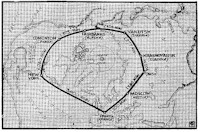 As nearly a thousand persons gathered at Stevenson airport around 6 o'clock Thursday morning, Howard Hughes and his daring crew were winging their way somewhere between Regina and Winnipeg. Their expected arrival shortly- before 5 a.m., was believed delayed by inclement weather conditions. Attempts to contact the ship by radio proved unsuccessful. Waiting with watches on hand were Cliff Kaake and Harry Nicholl, official clockers of the "Winnipeg Flying Club", and W. Lawson, secretary of the airport. At 2 a.m. the resources of the Imperial Oil Company, Winnipeg, went into action and two huge tank-wagons of gasoline, containing more than 1,700 gallons were rushed up. There were two kinds of gasoline, 450 gallons of the potent, 100-octane gas, used for take-offs, and more than 1,200 gallons of 87-octane gas a highly refined cruising fuel, used only by Trans-Canada Air Lines planes in Canada. As nearly a thousand persons gathered at Stevenson airport around 6 o'clock Thursday morning, Howard Hughes and his daring crew were winging their way somewhere between Regina and Winnipeg. Their expected arrival shortly- before 5 a.m., was believed delayed by inclement weather conditions. Attempts to contact the ship by radio proved unsuccessful. Waiting with watches on hand were Cliff Kaake and Harry Nicholl, official clockers of the "Winnipeg Flying Club", and W. Lawson, secretary of the airport. At 2 a.m. the resources of the Imperial Oil Company, Winnipeg, went into action and two huge tank-wagons of gasoline, containing more than 1,700 gallons were rushed up. There were two kinds of gasoline, 450 gallons of the potent, 100-octane gas, used for take-offs, and more than 1,200 gallons of 87-octane gas a highly refined cruising fuel, used only by Trans-Canada Air Lines planes in Canada.
Howard Hughes finally reported in with a direct short wave radio broadcast to his flight headquarters here at 3.00 a.m. (E.D.T.) today, Thursday, that the plane was 975 miles out of Fairbanks and flying at an altitude of 14,500 feet. The plane was heading directly for Winnipeg.
An amateur radio station at Hermosa Beach, Calif., reported to flight headquarters it contacted the plane and that one of the crew members said lightning had been observed in the vicinity. The message indicated the fliers were leaving British Columbia and crossing into Alberta. It was sent in code because electrical disturbances temporarily forced discontinuance of direct voice broadcasts.
At 6 o'clock, scores of cars were flocking to the airfield from all directions. The field was roped off and Chief of Police Garside and his staff were on hand to see that order was maintained. The plane was expected to land in Winnipeg within half an hour at the time of going to press.
(You can view/download a Popular Mechanics article about this flight at: www.jitterbuzz.com/manreal/hughes_rtw.pdf)
(Unfortunately, Howard Hughes elected to bypass Winnipeg and flew on to New York - eds) |
|
 |
|

Terry's Trivia and Travel Tips
|
|
|
|
 Air Canada Baggage Guide Air Canada Baggage Guide
Air Canada has assembled information on their baggage policies, as well as details on their products and services. It is their hope that you’ll use this information to plan and personalize your trip with them, and create your ultimate travel experience.
For complete baggage information see the Baggage Guide by following this link or by clicking on the image below. You can then use the links on that page to visit various other information more related to what information you are attempting to retreive such as the baggage fee calculator at www.aircanada.com/en/travelinfo/airport/baggage/checked.html and entering your flight information.

Another source for baggage information can be retrieved from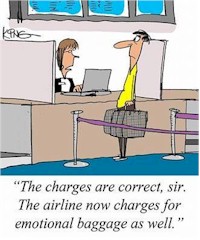 the web site at: www.seatguru.com which provides a more simplified version of Air Canada's baggage policies see: www.seatguru.com/airlines/Air_Canada/baggage.php the web site at: www.seatguru.com which provides a more simplified version of Air Canada's baggage policies see: www.seatguru.com/airlines/Air_Canada/baggage.php
Other Airline info can also be retrieved from www.seatguru.com/browseairlines/browseairlines.php
(Note: John Shea sent us the timely related cartoon on the right via his niece Karen Shea Gleason.)
Airline Club of Thailand Presents Japan 02 - 08 - April 2016.
Journey to the Land of the Rising Sun, to breathtaking scenery from the cities to the country side. Enjoy a feast of attractions with the seven day tour.
Prices are per person :
- Double /TWIN Sharing USD 2,700 (15pax) Single supplement USD 380
- Extra night in Tokyo USD 160 per day approx.
- In Osaka USD 140 per day approx.
Price confirmed based on :
- 6 nights accommodation as quoted or similar.
- Meals include 6 breakfasts 5 lunches, 6 dinners.
- Long distance coach and Shinkansen (Bullet Train)
- Accident insurance liability withinTHB 2,000,000 equivalent to approx USD 60,000.
- Tours as per itinerary.
- English speaking guide.
- In case of currency fluctuations of more than 3% we reserve the right to adjust the tour price.
Excluded-
- WACA fee of USD 20
- Tips for all local services (driver, local guide, porters) approx USD 6 per day per person
- Deadline to register - March 1st, 2016.
Interline Clube de Portugal will host the 1st WACA FUN GAMES.
- 19th - 23rd Apil 2016 at Vilamoura - Algarve, Portugal.
- Cost eur370.00 Deadline March 15th 2016
- Check www.waca.org events for full details.
Heathrow celebrates its 70th anniversary in 2016.
 December 31, 2015 marked 70 years since Heathrow officially became a commercial airport. Over the course of 2016, Heathrow will be celebrating a number of key moments with colleagues, passengers and the local community to mark this significant anniversary. May 31 is the official date of Heathrow’s birthday – marking 70 years since the then newly named London Airport officially opened for civilian aviation. Heathrow was originally built for military purposes during the Second World War and was handed over by the Air Ministry to the Minister of Civil Aviation on January 1, 1946. December 31, 2015 marked 70 years since Heathrow officially became a commercial airport. Over the course of 2016, Heathrow will be celebrating a number of key moments with colleagues, passengers and the local community to mark this significant anniversary. May 31 is the official date of Heathrow’s birthday – marking 70 years since the then newly named London Airport officially opened for civilian aviation. Heathrow was originally built for military purposes during the Second World War and was handed over by the Air Ministry to the Minister of Civil Aviation on January 1, 1946.
The first commercial flight to depart was a British South American Airlines Lancastrian ‘Star Light’ which flew to Buenos Aires on New Year's Day 1946, with the then London Airport opening to passengers the following May 31st.
Since its opening, the UK’s only hub airport has grown significantly to handle over 73 million passengers annually.
A brief History of Heathrow
- 1944: Construction of London Airport's runways begins
- 1946: London Airport officially opens as a commercial airport
- 1955: Her Majesty the Queen opens the Central Terminal Area and Control Tower
- 1957: The first non-stop flight to California sets a new record for distance and time
- 1964: The Beatles are mobbed at London Airport
- 1966: The British Airports Authority is created. London Airport is renamed 'Heathrow'
- 1969: Terminal 1 is opened and existing buildings renamed Terminals 2 and 3
- 1976: Concorde makes its first passenger flight
- 1977: The London Underground link is opened
- 1986: His Royal Highness Prince Charles and Princess Diana inaugurate Terminal 4
- 1987: The British Airports Authority is privatised as BAA plc
- 1997: The Terminal 5 public planning inquiry ends – the longest in UK history
- 1998: The Heathrow Express rail service is launched
- 2003: Three Concorde’s make their final touchdown at Heathrow
- 2006: The Airbus A380 makes its first UK landing into a newly built Pier 6 at Terminal 3
- 2007: A new air traffic control tower is operational – the tallest in the UK
- 2008: Terminal 5 is officially opened by Her Majesty The Queen in March; The first commercial A380 flight arrives at Heathrow
- 2009: Terminal 4 underwent a major refurbishment to improve facilities
- 2010: Demolition work started on Terminal 2 to make way for its £1 billion replacement which opens on 4 June 2014
- 2014: The brand new Terminal 2: The Queen's Terminal opened for business on 4 June. The first airline to move in was United Airlines
- 2015: Icelandair moved in to Terminal 2 on 25 March
- 2015: Terminal 1 closed
|
|
 |
|

Smileys
|
|
|
|
Heard on the air waves.
Lost student pilot: "Unknown airport with Cessna 150 circling overhead, please identify yourself."
Tower: Have you got enough fuel or not?
Pilot: Yes.
Tower: Yes what?
Pilot: Yes SIR! |
|
 |
|
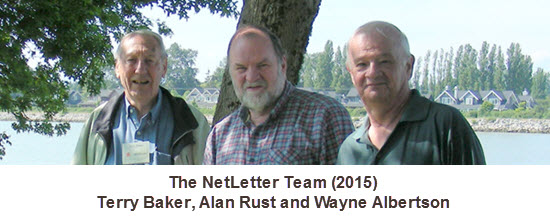 |
|
|
|
 |
| If you would like to be removed from this mailing list, then please, unsubscribe |











































 1951 - August - Timetable Canadian Pacific Airlines from the private collection of Bjorn Larsson.
1951 - August - Timetable Canadian Pacific Airlines from the private collection of Bjorn Larsson.


 Wayne's Wings
Wayne's Wings







